
REVIEW ARTICLE
Needs of countries with longer timescale for deep geological
repository implementation
Bálint Nős
*
Strategical and Technical Directorate, PURAM, HRSZ.: 8803/2, 7031 Paks, Hungary
Received: 12 March 2019 / Accepted: 16 September 2019
Abstract. Countries operating nuclear power plants have to deal with the tasks connected to spent fuel and
high-level radioactive waste management. There is international consensus that, at this time, deep geological
disposal represents the safest and most sustainable option as the end point of the management of high-level waste
and spent fuel considered as waste. There are countries with longer timescale for deep geological repository
(DGR) implementation, meaning that the planned date of commissioning of their respective DGRs is around
2060. For these countries cooperation, knowledge transfer, participation in RD&D programmes (like EURAD)
and adaptation of good international practice could help in implementing their own programmes. In the paper
the challenges and needs of a country with longer implementation timescale for DGR will be introduced through
the example of Hungary.
1 Introduction and background
1.1 Countries with longer implementation timescale
Nuclear Power Plants are operated since 1970s and 1980s in
Central and Eastern European (CEE) countries. This
means that these countries have to deal with spent fuel
management, including the final disposal of high-level
radioactive waste (HLW): spent nuclear fuel or vitrified
HLW corresponding to the direct disposal or reprocessing
option, respectively, for the back-end of the nuclear fuel
cycle. As it is formulated in the Council Directive 2011/70/
EURATOM (Directive) [1]: “it is broadly accepted at the
technical level that, at this time, deep geological disposal
represents the safest and most sustainable option as the end
point of the management of high-level waste and spent fuel
considered as waste.”
Taking into account the above mentioned, most of the
CEE countries have to face the challenge of implementing a
deep geological repository, the programs for which are in an
early stage, so these countries could be named as: “countries
with longer timescale for deep geological repository
implementation”(countries with longer implementation
timescale). Usually the planned commissioning date for
deep geological repositories (DGRs) in these countries is
around 2055–2065 (see Fig. 1).
Nevertheless, when a country is in an early stage of
implementation, it is essentially important from several
aspects (and it is required by the Directive [1]), to develop a
long-term programme and an underpinning RD&D plan
for the implementation of a DGR. A long-term
programme, with its technical contents and connected
cost calculations is necessary to collect enough funding for
the long-term liabilities, meeting the general principle that
requires not leaving undue burden on future generations.
1.2 The need for cooperation and assistance
Because of the small scale of the nuclear industry
including radioactive waste management in CEE
countries, providing the necessary resources (human,
technical, financial, etc.) for deep geological repository
implementation through decades could be more challeng-
ing. Very useful guidance documents exist to assist
Member States in the development of their long-term
programme and the connected RD&D plan.
The NAPRO working group of the European Nuclear
Energy Forum has drafted a guide (NAPRO Guide [3])
with the aim of assisting the Member States in the
establishment of their National Programmes, addressing
among others guidance on how to develop a comprehensive
programme for all waste streams, showing the management
routes from the generation until the final disposal in
dedicated repositories. From all waste streams, the biggest
challenge is to find a management route and implement the
programme for the disposal of HLW and spent nuclear fuel.
The Directive [1] prescribes that, “the National
Programmes shall include (…) the research, development
and demonstration activities that are needed in order to
*e-mail: balint.nos@rhk.hu
EPJ Nuclear Sci. Technol. 6, 22 (2020)
©B. Nős, published by EDP Sciences, 2020
https://doi.org/10.1051/epjn/2019042
Nuclear
Sciences
& Technologies
Available online at:
https://www.epj-n.org
This is an Open Access article distributed under the terms of the Creative Commons Attribution License (https://creativecommons.org/licenses/by/4.0),
which permits unrestricted use, distribution, and reproduction in any medium, provided the original work is properly cited.

implement solutions for the management of spent fuel and
radioactive waste”. The NAPRO Guide [3] contains some
general guidance on how to meet this requirement. More
specific assistance on RD&D planning can be found in the
PLANDIS Guide [4], which was developed by the SecIGD2
Project. The PLANDIS Guide was intentionally focused on
the needs of the countries with longer implementation
timescale (or countries with less-advanced programmes).
Cooperation at the international level can assist these
countries in facing some of these challenges. Some of the
CEE countries follow the so-called “dual track approach”,
meaning that they are considering the possibility of shared
solutions for disposal either as a preferred or as an
alternative option. From the technical and financial point
of view, the shared disposal option is a rational idea to solve
the problems, however, beside the technical issues, more
complex legal, financial and political questions have to be
answered.
Another important circumstance is the fact that there
are countries with mature, advanced DGR implementation
programmes. These countries accumulated a vast amount
of information and experience during the past few decades.
This knowledge base could be adapted by countries with
longer implementation timescale for their own situations,
within their boundary conditions. In this respect, the
EURAD project (European Joint Programme on Radioac-
tive Waste Management) could play an important role in
collecting the state of knowledge and developing training
modules in different areas.
In the next chapters, the example of Hungary is used to
illustrate the specific boundary conditions, current situa-
tion of a programme and R&D needs of a country with
longer implementation timescale.
2 Programme boundary conditions
2.1 National policy
The Hungarian Parliament, in accordance with the
requirements of the Directive, adopted the national policy
document on the management of spent nuclear fuel and
radioactive waste (national policy). The national policy
summarizes the principles applicable to the management of
spent nuclear fuel and radioactive waste. Most of these
principles were promulgated in the Hungarian legal
regulation mainly in the Act CXVI of 1996 on nuclear
energy (Atomic Act) and its implementing decrees before
the adoption of a national policy, but have also been recast
according to the requirements of the Directive in a
systematic manner. Some of the important principles from
the national policy which are relevant for the DGR
implementation programme are highlighted below:
–during the use of atomic energy, safety has priority over
any other aspects;
–the Hungarian state shall assume ultimate responsibility
for the management of spent fuel and radioactive waste
generated in Hungary (with some special exemptions for
spent sealed radiation sources and research reactor spent
nuclear fuel);
–the primary responsibility for safety rests with the license
holder of the facility or activity;
–during the use of atomic energy, the safe final disposal of
the generated radioactive wastes and spent nuclear fuel
shall be provided in line with the latest justified scientific
results and the international recommendations and
experience in such a way that no undue burden is
transferred to future generations.
According to the national policy, the final decision
concerning the back-end of the fuel cycle of power reactors
is not yet necessary to be made, but it is important to state
that the country must address the management of high-
level radioactive waste regardless of the chosen back-end
option. The most suitable and most widely accepted
solution to this is final disposal in a deep geological disposal
facility. The policy concerning the back-end of the fuel
cycle follows the “do and see”principle, meaning that an
open fuel cycle i.e. direct, domestic disposal of spent fuel
originating from nuclear power plants has been determined
as the reference scenario, which provides the basis of the
relevant cost estimates concerning the currently operating
four units. Domestic and international developments
concerning the back-end of the fuel cycle must be followed
(“see”) and, if necessary, must be incorporated into the
policy of the back-end of the fuel cycle, while at the same
time progress must be made on the site selection of the
domestic deep geological disposal facility (“do”[5]).
2.2 National framework
The Hungarian Atomic Energy Authority (HAEA) was
established in Hungary, as an independent regulatory
body, responsible for the supervision and licensing of
nuclear facilities and radioactive waste repositories, from
nuclear safety, radiation protection and physical protec-
tion point of view.
Fig. 1. Planned start of operation of deep geological facilities in the EU [2].
2B.Nős: EPJ Nuclear Sci. Technol. 6, 22 (2020)

In accordance with the Atomic Act, the Hungarian
government appoints an organization to carry out the tasks
related to
–the preparation of the national policy and national
programme;
–the final disposal of radioactive waste;
–the interim storage of spent fuel and the back-end of the
nuclear fuel cycle;
–the decommissioning of nuclear facilities.
In 1998, the legal predecessor of Public Limited
Company for Radioactive Waste Management (PURAM)
the waste management organization of Hungary was
established to cover the above mentioned tasks and
responsibilities.
On the basis of the Atomic Act, a segregated state
financial fund, the Central Nuclear Financial Fund (Fund)
was created in 1998. This provides funding for the
management of radioactive waste and spent fuel, and for
the tasks related to the decommissioning of nuclear
facilities. The costs of managing spent fuel and radioactive
waste are to be borne by those who produced these
materials through making payments into the Fund.
2.3 Main milestones of DGR implementation
The national programme of Hungary for spent nuclear fuel
and radioactive waste management was adopted by the
Hungarian government. At the level of the national
programme, the coherence and interrelations between
the management of the different waste streams were taken
into account, and the main milestones of DGR implemen-
tation were set.
After consecutive phases of surface-based investiga-
tions (see Fig. 2), the site is selected and an underground
research laboratory is planned to be constructed from 2032
at that site. During the operation of the URL, the in situ
underground investigation, site confirmation activities will
take place in the first period, while in the second period, the
focus will move to the demonstration programs with the
aim of preparing the construction and operation. The start
of the construction of the DGR is scheduled for 2055 and
the operation for 2064.
The first conceptual plan [6] describing the disposal
system of the DGR was developed in 2005. This plan
contained the first cost calculations of the whole pro-
gramme. In 2008, the technical and financial update of the
long-term investigation programme of the Boda Claystone
Formation [7] was compiled. In principle the time schedule
of the implementation programme for the DGR and the
cost estimate are based on this document. The long-term
investigation programme was reviewed by the Swiss
NAGRA, who had given useful comments on the
document.
At this early stage of site selection, it is necessary also
for countries with longer implementation timescale to
develop a long-term implementation programme and a
connected R&D plan, in order to have an idea about the
technical content and the cost implications of the project.
This is important, because on the basis of the cost
calculations enough money has to be collected in the fund
during the operation of the NPPs. In the Hungarian cost
profile, the deep geological disposal project is the most
expensive element, so the technical content of the
programme has to be justified, and the cost estimates
have to be defendable.
Due to the very long timescale of the implementation of
deep geological disposal programme, maintaining the core
competences within a waste management organization and
keeping educated, skilled and experienced workforce for
decades could be a challenge mainly for countries with
longer implementation timescale. Participation in interna-
tional R&D projects could be a good instrument to attract
young people into the radioactive waste management
business and this approach could be justified in those cases
as well, when the results of a given R&D task will be used
much later in the national programme of the interested
country.
3 Development of a R&D framework
programme
3.1 Introduction
In Hungary, the preparations for the disposal of spent
nuclear fuel and HLW started in 1993. In 1994, an
exploration tunnel was excavated in the Mecsek Uranium
Mine, reaching the Boda Claystone Formation (BCF), and
onsite underground data acquisition began at a depth of
∼1050 m. The formation was explored underground by a
tunnel extending into the claystone ∼500 m. The tunnel
was utilized as an Underground Research Laboratory
(URL), and a large amount of onsite underground data was
collected. During this programme, the Hungarian partners
received technical assistance from the experts of the
Canadian AECL company. In 1998, the mine was flooded,
and the opportunity to perform underground investiga-
tions was terminated.
From 2000, based on desktop studies, a nationwide
screening was carried out by evaluating the potential host
rock formations in detail. Thirty-two lithological forma-
Fig. 2. Time schedule of the Hungarian DGR implementation programme.
B. Nős: EPJ Nuclear Sci. Technol. 6, 22 (2020) 3

tions potentially suitable for a deep geological repository,
within the territory of Hungary, were identified (see Fig. 3).
This comprehensive investigation in 2003 confirmed that
the BCF has the highest potential among the suitable host
rocks for hosting a DGR.
Between 2004 and 2017, there were two new starts for
the investigations of the BCF, but both programmes were
interrupted. This was a typical challenge of a small nuclear
country: due to the lack of enough resources it was difficult
to run three big programmes (continuous extension of the
interim storage facility for spent fuel, construction of an
underground repository for L/ILW and site selection
activities for a DGR) in parallel.
In 2018, PURAM drafted a new site investigation
framework programme for the BCF, based on the recently
extended governmental decree, which now contains the
requirements for the site selection phase. Both the modified
regulation and the new framework programme seriously
take into account the recommendations of the PLANDIS
Guide [4].
In the development of the site investigation framework
programme, PURAM could effectively use the methodo-
logical advices of the French waste management organi-
zation, ANDRA, which were transferred in the frame of a
cooperation agreement between the companies. The
cooperation agreement focused on project development
planning and functional analyses. It should be emphasized
that it was important for the colleagues of PURAM to
understand the methodology, the rationale behind that
and implement it within the Hungarian boundary
conditions. The experts of ANDRA also promoted this
kind of adaptation (instead of copying) and mentoring
programme, which provided a real added value for
PURAM from a country with longer implementation
timescale.
3.2 Structure of the site investigation framework
programme
The long-term safety of the disposal facility relies on
multiple barriers (and multiple safety functions). In case of
a deep geological repository, the host formation and the
geological barrier play an extremely important role in
meeting the post-closure safety targets. Accordingly, the
site investigation framework programme has an indepen-
dent annex for geological investigations. In the main text,
meeting the regulatory requirements, the R&D activities
are structured in the following areas:
–waste inventory amount, activity content, physical–
chemical form;
–waste package (waste form and package) geometry,
properties, long-term behaviour, compatibility with
other elements of the disposal system;
–engineered barrier system (buffer, backfill, seals and
plugs) geometry, properties, long-term behaviour,
compatibility with other elements of the disposal system;
–geological and natural environment of the facility
properties and long-term evolution of the geological
barrier, external natural hazards relevant for the safety of
the facility (this area is elaborated in detail in the
Fig 3. Ranking of the formations in Hungary during the screening 2000–2003.
4B.Nős: EPJ Nuclear Sci. Technol. 6, 22 (2020)

geological investigation programme, which is an inde-
pendent annex of the framework programme);
–preliminary design and layout of the surface and
underground part of the facility;
–operation of the facility, transport and transfer of waste
packages, ensuring retrievability/reversibility;
–methods for R&D investigations, models, evaluation;
–data management, and long-term information
preservation.
3.3 Phases of the site investigation framework
programme
The phases (see Tab. 1) of the R&D activities for the
surface-based investigation period (with site selection and
preparations for the construction of the underground
research laboratory) were defined based on the targets of
the geological investigation program.
For each phase, a detailed site investigation plan has to
be prepared by PURAM and has to be submitted for
licensing to the regulatory body (HAEA). At the end of
each phase, a final investigation report and on the basis of
that a preliminary safety case has to be compiled, and the
site investigation framework programme has to be reviewed
and updated, if necessary, for the next phase(s). In this
preliminary stage of the Hungarian Programme, the safety
case is dominantly used (i) to help in understanding the main
processes and how the elements of the systems could fulfil
their safety functions; (ii) to identify the uncertainties and
knowledge gaps, and (iii) through sensitivity analyses to
prioritize the R&D needs.
3.4 Investigation area
An investigation area (86.7 km
2
) was identified for the site
investigation framework programme in such a way that
this contains all relevant field investigation locations
within its boundary (see Fig. 4, green line). The surface
projection of the potential disposal zone (32.6 km
2
)the
area, where the Boda Claystone Formation can be found at
the depth between 500 m and 1000 m is also shown on
this map (Fig. 4, brown line).
The investigation area is important from the public
participation point of view as well. In the licensing
procedure for the site investigation framework programme
and site investigation plan, a public hearing is organized by
the HAEA. All interested people can participate and those
who own a property within the investigation area have a
“client right”in the licensing process.
3.5 Goals of the investigation phases
The general aim of the investigation phase I is data
acquisition for site characterization and ranking the
candidate areas for phase II. Four special goals were
identified for phase I:
–understanding of the geological environment in such
detail that the ranking of the candidate areas can be
made;
–evaluation of unfavourable site properties and exclusion
criteria and screening out of those;
–detailed investigation of the host formation;
–data acquisition for the preliminary safety case.
Phase II of the investigations will focus on a reduced
10 km
2
area. The general aim of investigation phase II is
data acquisition for designating the location of the
underground research laboratory. Special goals of investi-
gation phase II are:
–designation and surface-based characterization of the
site, confirmation of geological suitability;
–designation of the location of the surface and under-
ground facilities and the underground research
laboratory;
–data acquisition for the conceptual design of the facility;
–data acquisition for the preliminary safety case.
The general aim of investigation phase III is data
acquisition and the preparation of the underground
research laboratory and for the site licence application.
Special goals of investigation phase III are:
–characterization of the geological environment of the
previously designated location for the surface and
underground parts of the facility in such details that
the site licence application could be compiled;
–preparation of the underground research laboratory and
planning the investigation program to be conducted in it;
–evaluation of the reference state of the site for the
environmental impact assessment;
–data acquisition for the safety case, substantiating the
site licence application.
The field investigations of phase III are focused on a
few km
2
area of the site.
During the three above mentioned phases, in parallel
with the geoscientific investigations, the relevant R&D
activities have to be carried out for the different elements of
the disposal system: waste inventory, waste form, packag-
ing, engineered barrier system (buffer, backfill, seals and
plugs). The preliminary conceptual design of the under-
ground and surface facilities has to be developed.
Table 1. Main goals and durations of the surface-based investigation phases.
Surface-based investigation
Investigation phase I
2019–2023
Investigation phase II
2024–2029
Investigation phase III
2030–2032
General data acquisition in order
to rank candidate areas
Site selection and characterization
of chosen site
Preparations of the URL
B. Nős: EPJ Nuclear Sci. Technol. 6, 22 (2020) 5

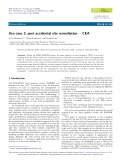
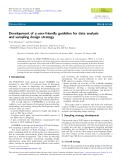
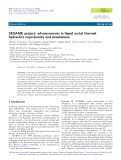
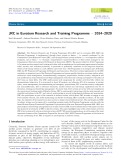
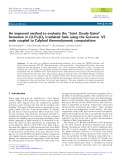
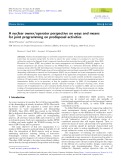
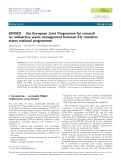

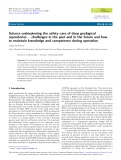
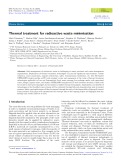







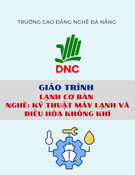
![Ngân hàng trắc nghiệm Kỹ thuật lạnh ứng dụng: Đề cương [chuẩn nhất]](https://cdn.tailieu.vn/images/document/thumbnail/2025/20251007/kimphuong1001/135x160/25391759827353.jpg)






